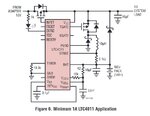ben5243
Member level 3

I've built an LTC4011 circuit, schematic here:

Everything works but the FETs get scorching hot in seconds.
I had previously built another with FDD6637 and SUD50N04-8M8P-4GE3 FETs which also got hot but not as bad, these were supposed to make less heat, not more
So these new FETs should theoretically create less heat and be more efficient, right?
Is this possibly a reverse recovery problem? Or current shoot-through?
Also attached is the relevant layout of the components.

Everything works but the FETs get scorching hot in seconds.
PMOS = Si7145DP
NMOS = SiR422DP
Choke = 7447709100
LTC4011 Datasheet
Vin = 24V
Vout = 12..15V (10S nimh batt)
I had previously built another with FDD6637 and SUD50N04-8M8P-4GE3 FETs which also got hot but not as bad, these were supposed to make less heat, not more
PMOS:
Old Rds_ON = 18mR
New Rds_ON = 3.8mR
Old Rja = 40 C/W
New Rja = 20 C/W
NMOS:
Old Rds_ON = 10.5mR
New Rds_ON = 6.6mR
Old Rja = 40 C/W
New Rja = 25 C/W
So these new FETs should theoretically create less heat and be more efficient, right?
Is this possibly a reverse recovery problem? Or current shoot-through?
Also attached is the relevant layout of the components.










